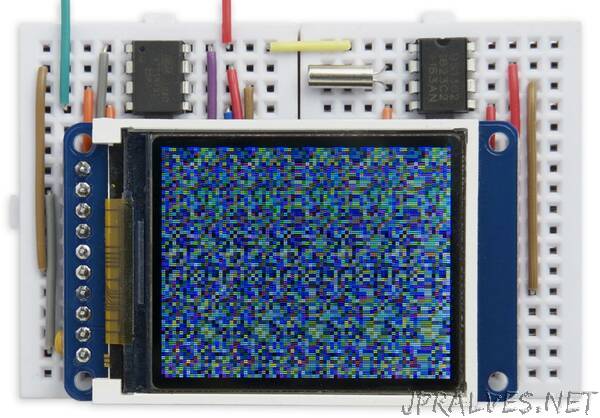
“This clock displays the time as an autostereogram on a colour TFT display. The time is invisible until you view it with your eyes focussed in the distance, when the time will jump out in 3D, appearing as four digits.
It uses an ATtiny85 driving a TFT 160x80 colour display, and the timekeeping is done by a DS1302 RTC chip.
Introduction
This isn’t perhaps the most convenient way of seeing the time, but it’s a fun demonstration of autostereograms, made popular by the Magic Eye books of the 1990s. It’s ideal if you don’t want to be constantly reminded of the time, but want to be able to check it when you need it.
To view the clock you need to focus on a point behind the clock until the random dots snap together to create a new image, with the time shown in 3D.
The background
The fact that we’ve got two eyes is what enables us to deduce how far away things are. For example, if you’re viewing a bush in front of a hedge we know that the bush is nearer than the hedge because the image of the bush is shifted relative to the hedge in one eye compared to the other. If you viewed the scene with just one eye you’d see a texture of leaves that gave no information about distance.
Autostereograms take advantage of the brain’s ability to process the images from both eyes to generate depth information, using computer-generated images. To understand how autostereograms work we first need to start from stereoscopic photographs.
Stereoscopic photographs
A stereoscopic photograph is a pair of photographs, taken from slightly different camera positions corresponding to the distance between the eyes. When viewed with the eyes slightly diverged, or through a viewer, the brain combines the images to create the illusion of a 3D image. It became a craze in Victorian times [1], and more recently several cameras have been marketed to allow you to take and view sterescopic pictures.
Random-dot stereograms
The next development was the random-dot stereogram, discovered in 1919 [2]. This is a pair of identical random-dot fields; in one of the pair a shape has been shifted left or right. The shape is invisible until you merge the images, as with a stereoscopic photograph; the shape then stands out in 3D. This effect was influential in helping understand how the brain processes depth information in visual images.”
